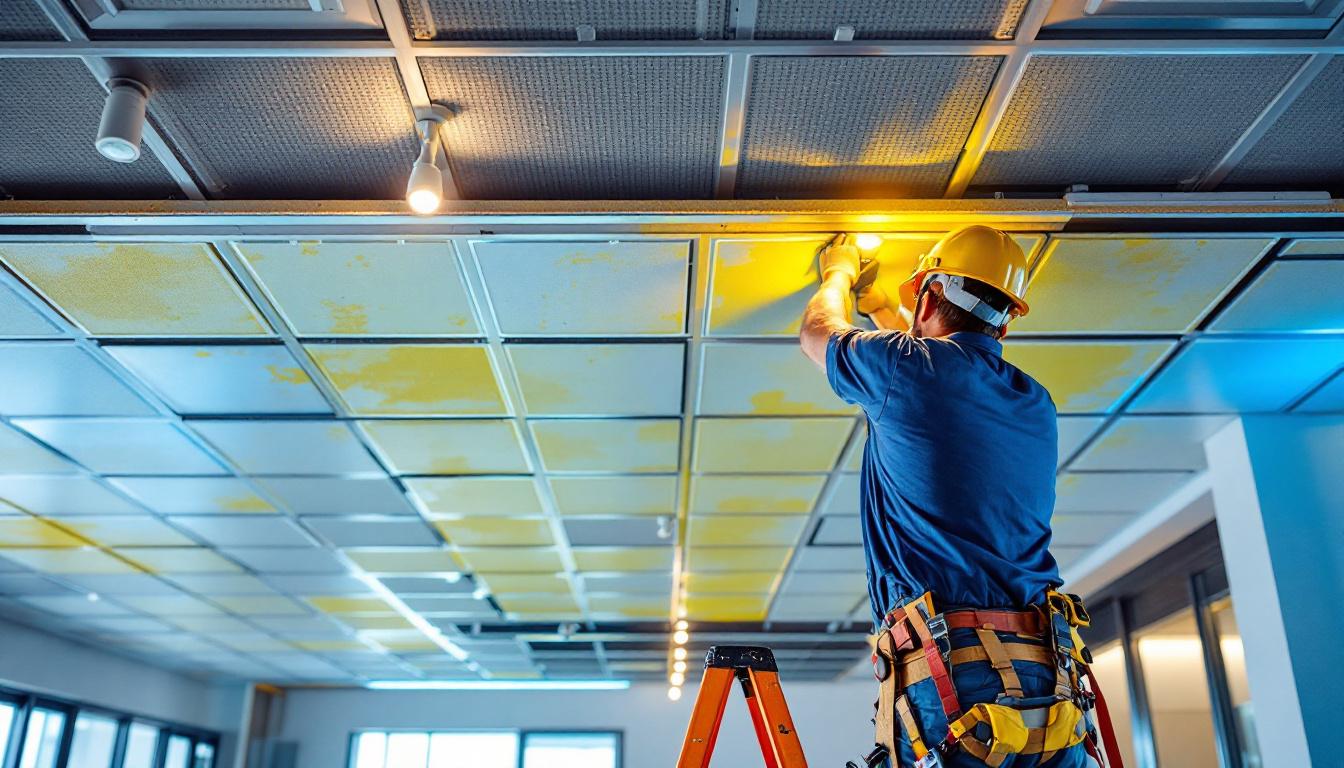
Drop ceilings, also known as suspended ceilings, are a staple in commercial and residential projects alike. For lighting contractors, understanding the cost structure of installing or modifying drop ceilings is crucial. It directly impacts project budgeting, client expectations, and the integration of lighting systems.
The price of a drop ceiling can vary widely depending on materials, labor, and the complexity of the installation. On average, costs range from $2 to $6 per square foot, but this is just the baseline. Factors such as ceiling tile quality, grid system type, and additional features like soundproofing or moisture resistance can push prices higher.
For lighting contractors, the cost is not just about the ceiling itself but also about how the ceiling interacts with lighting fixtures. Drop ceilings often dictate the type of lighting that can be installed, whether it’s recessed lights, LED panels, or track lighting. Knowing the ceiling’s cost and structure helps in advising clients on the best lighting solutions without exceeding budgets.
Additionally, the choice of ceiling tiles can significantly influence both aesthetics and functionality. For instance, tiles that offer enhanced acoustics are particularly beneficial in environments such as offices or conference rooms where sound control is paramount. Similarly, tiles with high light reflectance can improve overall brightness in a space, reducing the need for additional lighting fixtures. Lighting contractors should be well-versed in these options to provide comprehensive recommendations that align with the client’s needs and preferences.
Moreover, the installation process itself can introduce additional costs that contractors need to account for. Factors such as the height of the existing ceiling, the need for structural reinforcements, and the complexity of the lighting layout can all affect labor costs. For example, if the drop ceiling is being installed in a space with existing ductwork or plumbing, additional time and materials may be required to navigate these obstacles. Understanding these nuances not only aids in accurate cost estimation but also enhances the contractor’s credibility with clients, as they can anticipate potential challenges and provide informed solutions.
The two main components of a drop ceiling are the tiles and the grid system. Tiles come in various materials, including mineral fiber, fiberglass, metal, and PVC. Each material has its price point and performance characteristics. For instance, mineral fiber tiles are economical and offer decent acoustics, while metal tiles are pricier but provide durability and a modern aesthetic. Additionally, tiles can be treated with different finishes or textures, which can further influence their cost and visual appeal. For example, textured tiles can enhance sound absorption and add a unique design element to a space, making them a popular choice in creative environments like offices and studios.
The grid system, usually made of lightweight metal, supports the tiles and defines the ceiling’s layout. Standard grid systems are affordable, but specialized grids designed for seismic zones or heavy fixtures increase costs. Lighting contractors should consider grid strength and compatibility with lighting fixtures, as some grids can support integrated lighting panels more easily than others. Moreover, the choice of grid can also affect the overall aesthetic of the ceiling; for instance, a narrow grid can create a more streamlined look, while a wider grid might be more visible and contribute to a more traditional appearance.
Labor costs can be a significant part of the total expense. Installing a drop ceiling requires precision to ensure tiles are level and grids are securely fastened. Complex ceiling layouts with multiple levels, curves, or integrated lighting increase labor hours and costs. In addition to the physical installation, contractors often need to account for the time spent on planning and design, which can be particularly intricate in commercial spaces where aesthetics and functionality must align seamlessly.
For lighting contractors, coordinating installation with electricians is essential. If lighting fixtures need to be installed simultaneously or require cutting tiles to fit, the labor cost can rise. Efficient scheduling and clear communication between teams can help keep costs manageable. Furthermore, the presence of existing infrastructure, such as ductwork or plumbing, can complicate installation and necessitate additional adjustments, further impacting labor costs and timelines.
Specialty tiles with fire resistance, moisture resistance, or enhanced acoustics add to material costs. In environments like kitchens, bathrooms, or industrial spaces, these features are often non-negotiable. Lighting contractors should be aware of these requirements as they impact both ceiling and lighting fixture choices. For example, in a commercial kitchen, tiles that can withstand high humidity and grease are essential, while in a conference room, sound-dampening tiles can significantly improve the quality of meetings and presentations.
Other cost factors include ceiling height and accessibility. Higher ceilings may require scaffolding or lifts, increasing labor expenses. Easy access to the plenum space above the ceiling is also vital for lighting maintenance and upgrades, which can influence initial installation decisions. Additionally, considerations for future modifications or expansions should be made during the design phase, as a well-planned ceiling can save time and money in the long run. The ability to easily replace tiles or adjust lighting without extensive rework can be a significant advantage, particularly in dynamic environments where flexibility is key.
Drop ceilings limit the types of lighting fixtures that can be installed. Recessed lighting, for example, requires enough plenum space above the tiles to accommodate housings. LED panels designed to fit within the grid are popular for their slim profile and energy efficiency.
Lighting contractors must evaluate the ceiling’s grid size-commonly 2×2 or 2×4 feet-and select fixtures that fit seamlessly without cutting tiles excessively. Custom fixtures or modifications can increase costs and complicate installation.
Wiring for lighting in drop ceilings needs careful planning. The plenum space is often used to run electrical cables, but local codes may restrict certain wire types in this area. Lighting contractors should ensure compliance with regulations to avoid costly rework.
Additionally, integrating smart lighting controls or dimming systems requires coordination with ceiling installation. Pre-planning conduit paths and fixture placements can save time and money. Lighting contractors who collaborate early with ceiling installers tend to deliver smoother projects.
One advantage of drop ceilings is ease of access for maintenance. Lighting contractors should advise clients on choosing tiles that can be removed without damage to facilitate fixture replacement or upgrades.
Considering future lighting technology trends, such as tunable white or color-changing LEDs, during the initial installation can prevent expensive retrofits. This forward-thinking approach adds value and positions contractors as trusted advisors.
Balancing quality and cost is key. For many projects, standard mineral fiber tiles paired with a basic grid system provide a functional and affordable ceiling. However, if the client requires enhanced acoustics or aesthetics, selectively upgrading only certain areas can control costs.
Bulk purchasing of materials often yields discounts. Lighting contractors who establish relationships with suppliers can negotiate better rates, especially on frequently used items like tiles and grid components.
Coordinating ceiling and lighting installation schedules reduces downtime and labor costs. Avoiding rework by ensuring accurate measurements and clear communication between teams is critical. Using digital tools for project planning and layout visualization can minimize errors.
Training crews on best practices for drop ceiling installation and lighting integration improves efficiency. Experienced teams complete jobs faster and with fewer mistakes, directly impacting the bottom line.
Advancements in lighting technology, such as modular LED panels and wireless controls, simplify installation and reduce labor. These innovations often come with higher upfront costs but can lower long-term expenses through energy savings and easier maintenance.
Lighting contractors who stay informed about industry trends can recommend solutions that align with client budgets and expectations, enhancing reputation and repeat business.
An office space renovation involved replacing an outdated ceiling with a drop ceiling featuring integrated LED panels. The project covered 2,500 square feet, with material costs averaging $4 per square foot and labor at $3 per square foot.
The lighting contractor coordinated with the ceiling installer to select 2×4 LED panels that fit the grid perfectly. Pre-wiring for dimming controls was included, adding $0.50 per square foot. The total cost was approximately $18,750, balancing quality and energy efficiency.
A retail client requested a drop ceiling that improved acoustics and showcased merchandise lighting. Acoustic tiles with enhanced sound absorption were chosen, costing about $5.50 per square foot. The grid system was reinforced to support heavier track lighting fixtures.
Labor costs increased due to the complex layout and fixture installation, totaling $4 per square foot. The lighting contractor’s expertise in integrating track lighting with the ceiling grid ensured a seamless look. The project highlighted the importance of upfront planning and material selection.
In a healthcare setting, moisture-resistant drop ceiling tiles were mandatory. These tiles cost roughly $6 per square foot, with a specialized grid system to meet health codes. Lighting fixtures included recessed LED panels with antimicrobial surfaces.
Coordination with electrical contractors was essential to meet stringent regulations. The lighting contractor’s knowledge of code compliance and ceiling compatibility helped avoid costly delays. The project underscored the value of industry-specific expertise.
For lighting contractors, mastering the cost dynamics of drop ceilings is more than a budgeting exercise-it’s about delivering value and functionality. Understanding material options, labor implications, and integration challenges equips contractors to provide informed recommendations and avoid surprises.
Successful projects hinge on collaboration between ceiling installers, electricians, and clients. Early planning, clear communication, and attention to detail reduce costs and enhance outcomes. Lighting contractors who embrace these principles position themselves as indispensable partners in any drop ceiling project.
Ultimately, knowledge is power. Knowing the nuances of drop ceiling costs and lighting integration empowers contractors to navigate complex projects confidently, ensuring client satisfaction and business growth.
Ready to elevate your lighting projects with superior products that promise quality and affordability? Look no further than LumenWholesale. Our spec-grade lighting solutions are designed to meet the rigorous demands of any drop ceiling installation, ensuring you deliver excellence to your clients every time. By choosing us, you’re opting for unbeatable wholesale prices, free shipping, and the convenience of bulk buying without the hassle. Don’t let inflated markups dim your project’s potential. Wholesale Lighting at the Best Value is just a click away. Partner with LumenWholesale today and shine a light on savings and quality that make a difference.

Discover the essential best practices lighting contractors use when selecting and installing color temperature fluorescent bulbs.

Discover the transformative power of LED warehouse fixtures and why they’re indispensable for lighting contractors.

Discover the essential insights lighting contractors need to meet client expectations with T5 LED bulbs.

Discover expert insights and best practices for installing Keystone light fixtures in this comprehensive guide tailored for lighting contractors.